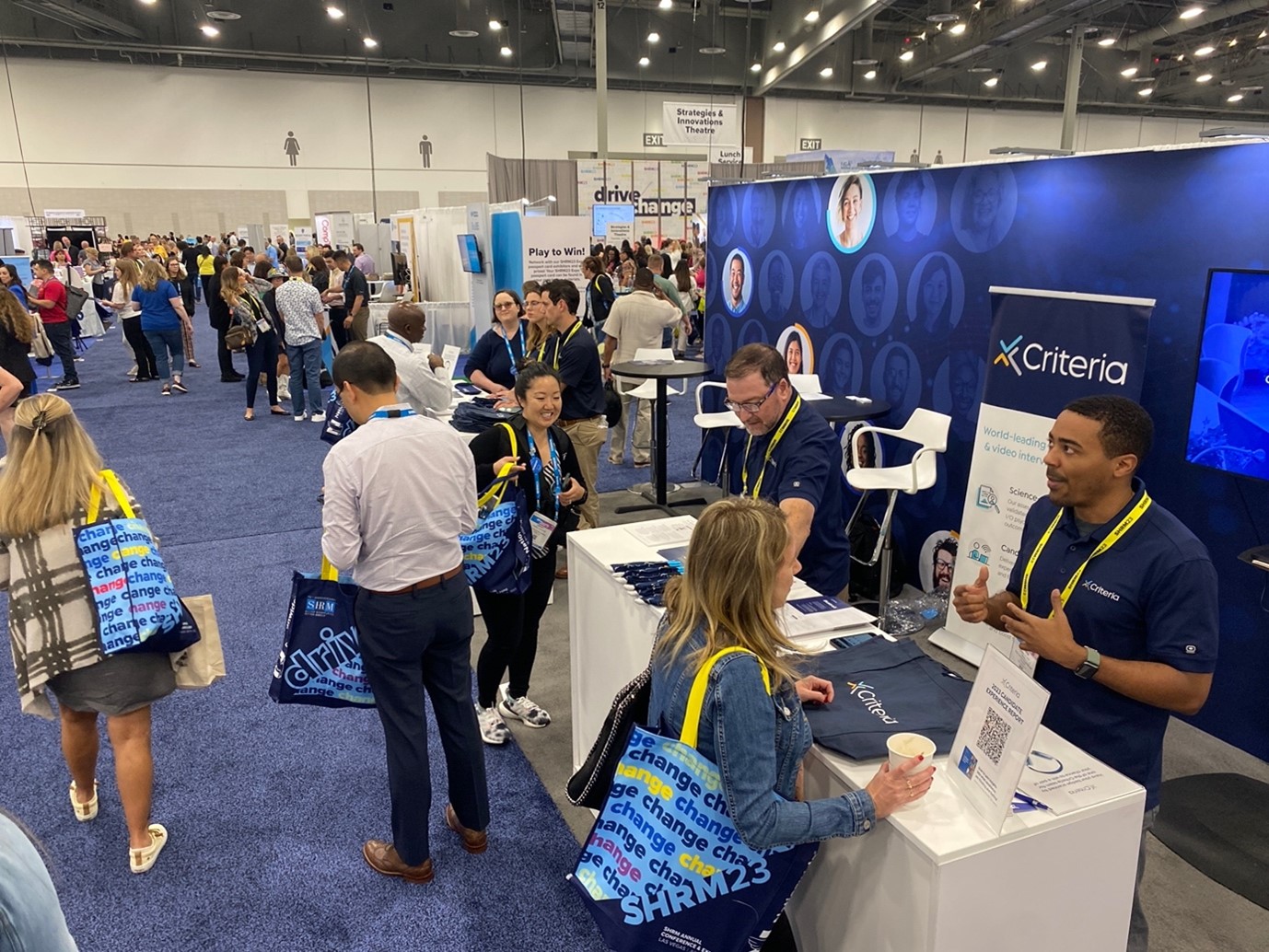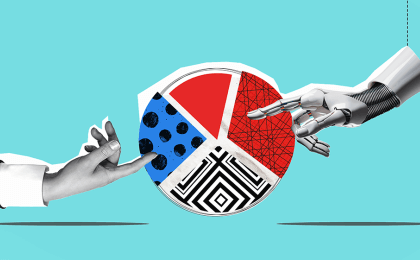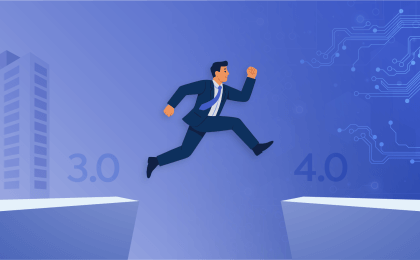Last month Criteria had the pleasure of attending and exhibiting at the 75th Annual SHRM Conference & Exhibition held in Las Vegas. With the theme of “Drive Change,” SHRM23 encouraged attendees to explore ways to initiate positive and meaningful change within their organizations.
The conference marked a historic milestone, gathering the largest assembly of HR professionals in SHRM’s history. Our team was blown away by the remarkable concentration of thought leadership and palpable energy that filled the air. We were thrilled to be exhibiting amongst more than 600 other leading HR providers, but above all, we loved personally connecting with each and every one of you who came to say hello and learn about Criteria. We hope you enjoyed the complimentary SWAG we shared, including our much-loved Criteria socks!

During the event, we gained invaluable access to insights from industry trailblazers which we are eager to share with you. Whether or not you were able to attend, we hope you find these key learnings thought-provoking and influential in shaping your future hiring and retention strategies. So, here are our top three takeaways from SHRM23…
1. Skills-based hiring is on the rise
As Former President Bill Clinton aptly put it to a packed room at SHRM23, “we shouldn’t require a college degree if the job doesn’t require it.” Being interviewed by SHRM’s Board Chair and CPO of Booz Allen Hamilton, Betty Thompson, Clinton advocated for a skills-first hiring approach to improve and support training for different groups of workers to help them qualify for jobs in need of talent – and we couldn’t agree more!
The traditional recruitment process leans heavily on information from resumes, and while resumes do give some insight into candidates’ experience and educational background, they don’t give you the whole picture or allow you to see what a candidate truly has to offer.
When you take into account skills beyond what's mentioned on a candidate's resume, you’re able to gain valuable insights that help you make smarter decisions about their fit for a role and their potential to succeed within your company. It's about looking beyond the surface and getting a more holistic understanding of what they bring to the table.
With rapid technological advancements and evolving job roles, a shift towards skills-based hiring and investing in upskilling and reskilling programs is no surprise. But what does skills-based hiring actually look like in practice?
It starts with creating job postings and descriptions that clearly highlight the essential skills and competencies needed for success in the role. Think about the specific technical skills, soft skills, industry-specific certifications, or knowledge areas that are crucial for the job. Instead of fixating on specific qualifications, focus on the desired results you want to achieve.
Once you've made your job requirements more accessible, the next step is assessing candidates' skills and potential. This is where assessments and structured interviewing come into play! Assessments provide a fair and objective way to evaluate candidates, enabling you to gather reliable information that allows you to make the best talent decisions possible. Meanwhile, structured interviewing allows you to simulate various scenarios or situations to observe how candidates might perform. Through scenario-based questions, you can uncover any gaps in their skills or knowledge that are essential for the role.
By prioritizing skills-based evaluations, you can better identify candidates who possess the necessary capabilities and potential to excel in the position. This approach ensures that your hiring decisions are grounded in objective assessments and aligned with the specific skills required for success in the role. So, you can look beyond the resume and highlight a candidate’s potential!
2. The role of AI in the future of work
Everyone has heard the buzz around AI and the role it plays in the future of work. In the panel session "The Road Ahead: The Intersection of Artificial Intelligence & Workplace Policy," panelists examined how HR professionals, policymakers, and regulators can approach automation in a way that ultimately benefits both workers and the workplace.
HR professionals are looking to AI technology and automated employment decision tools to meet the needs of their organization including talent acquisition, retention, performance management, and much more. But while AI brings advantages to the hiring process, it also carries certain risks, particularly around bias and discrimination, and lack of transparency.
(Check out this article authored by Criteria’s VP of Assessment, Dr. Matthew Neale, on how hiring managers can avoid dangerous misuses of generative AI, and how you can make the hiring process as fair and predictive as possible.)
Whether you sit on the for or against side of the AI fence, one thing is for certain – AI will play a role in the future of work. And HR professionals should use AI with care and remember that there are many ways to make the hiring process as fair and predictive as possible.
3. The mental health crisis is very real
The mental health crisis among employees is a significant and pressing issue that many organizations are facing. The CPO of Booz Allen Hamilton, Betty Thompson, opened the first day of SHRM23 by encouraging attendees to empower their managers to spot red flags and be the first line of defense in support for employees. But how can you “spot the red flags” early? Here are a few indicators that may suggest an employee is not coping well:
-
Decreased motivation and reduced productivity: You may notice a decline in the employee's motivation and enthusiasm towards work. They may seem less engaged, find it challenging to get started on tasks, or struggle to find meaning or purpose in their work. Decreased productivity, missed deadlines, and a decline in the quality of work can also be signs of burnout.
-
Increased absenteeism or presenteeism: Absences from work, including frequent sick leave or unexpected absences can be an indication that an employee is struggling. On the other hand, presenteeism, where employees are physically present but not fully engaged or productive may also indicate burnout.
-
Lack of enthusiasm and engagement: A significant decrease in enthusiasm, engagement, or interest in work-related activities can signal burnout. Employees who once displayed passion and dedication may become disengaged, disconnected, or indifferent.
-
Deteriorating relationship and communication: Notice changes in an employee’s interpersonal relationships, such as increased conflicts or strained interactions with colleagues, managers, or clients. Communication may become more negative, defensive, or lacking in clarity.
Considering the urgent and significant mental health crisis faced by employees, organizations can take several measures to support those who are struggling. These include fostering a work culture that promotes support and understanding, providing resources and support services for mental health, promoting a healthy work-life balance, implementing stress management programs, training managers in offering mental health support, and reducing the stigma associated with mental health issues. By prioritizing the mental health of their employees, organizations can establish a work environment that is healthier, more productive, and sustainable.
On the flip side, during the hiring process, hiring managers should proactively identify candidates who are likely to cope well under stressful situations to prevent burnout in the future. Research suggests that emotional intelligence (EI) plays a role in an individual's ability to handle stress, as those with higher levels of EI tend to exhibit resilience and are less prone to burnout. So, how can hiring managers assess a candidate's EI? Emotional intelligence tests can gauge a candidate's capacity to accurately perceive, understand, and manage emotions. You can try Criteria's emotional intelligence test here!
A summary of our three key takeaways:
-
The key to skills-based hiring is assessing candidates beyond their resume to identify their true potential
-
AI offers advantages but requires careful consideration to avoid bias and discrimination
-
Organizations must prioritize employee well-being by fostering a supporting work culture.
That’s a wrap — we look forward to seeing you at our next event!





